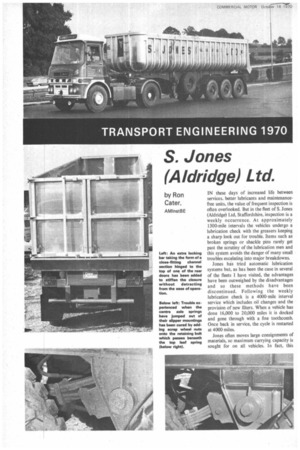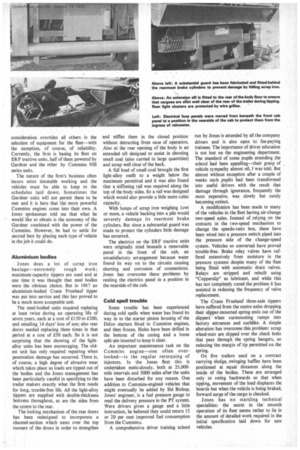S. Jones (Aldridge) Ltd.
Page 54

Page 55

If you've noticed an error in this article please click here to report it so we can fix it.
by Ron Cater,
AM InstBE
IN these days of increased life between services, better lubricants and maintenancefree units, the value of frequent inspection is often overlooked. But in the fleet of S. Jones (Aldridge) Ltd, Staffordshire, inspection is a weekly occurrence. At approximately 1300-mile intervals the vehicles undergo a lubrication check with the greasers keeping a sharp look out for trouble. Items such as broken springs or shackle pins rarely get past the scrutiny of the lubrication men and this system avoids the danger of many small troubles escalating into major breakdowns.
Jones has tried automatic lubrication systems but, as has been the case in several of the fleets I have visited, the advantages have been outweighed by the disadvantages and so these methods have been discontinued. Following the weekly lubrication check is a 4000-mile interval service which includes oil changes and the provision of new filters. When a vehicle has done 16,000 to 20,000 miles it is docked and gone through with a fine toothcomb. Once back in service, the cycle is restarted at 4000 miles.
Jones often moves large consignments of materials, so maximum carrying capacity is sought for on all vehicles. In fact, this consideration overrides all others in the selection of equipment for the fleet—with the exception, of course, of reliability. Currently, the firm is basing its fleet on ERF tractive units, half of them powered by Gardner and the other by Cummins NH series units.
The nature of the firm's business often incurs strict timetable working and the vehicles must be able to keep to the schedules laid down. Sometimes the Gardner units will not permit these to be met and it is here that the more powerful Cummins engines come into their own. A Jones spokesman told me that what he would like to obtain is the economy of the Gardner combined with the power of the Cummins. However, he had to settle for second best by placing each type of vehicle in the job it could do.
Aluminium bodies Jones does a lot of scrap iron haulage—extremely rough work; maximum-capacity tippers are used and at one time it was thought that steel bodies were the obvious choice. But in 1967 an aluminium-bodied Crane Fruehauf tipper was put into service and this has proved to be a much more acceptable unit.
The steel-bodied units required replating at least twice during an operating life of seven years, each at a cost of £150 to £200, and entailing 14 days' loss of use; also rear doors needed replacing three times in that period at a cost of £50 each. So it is not surprising that the showing of the lightalloy units has been encouraging. The oldest unit has only required repairing when penetration damage has occurred. There is, of course, a high degree of abrasive wear which takes place as loads are tipped out of the bodies and the Jones management has been particularly careful in specifying to the trailer makers exactly what the firm needs for long, trouble-free life. All the light-alloy tippers are supplied with double-thickness bottoms throughout, as are the sides from the centre to the rear.
The locking mechanism of the rear doors has beep redesigned to incorporate a channel-section which nests over the top runners of the doors in order to strengthen
and stiffen them in the closed position without detracting from ease of operation. Also at the rear opening of the body is an extended sill designed to assist in shooting small coal (also carried in large quantities) and scrap well clear of the back.
A full load of small coal brought the first light-alloy outfit to a weight below the maximum permitted and it was also found that a stiffening rail was required along the top of the body sides. So a rail was designed which would also provide a little more cubic capacity.
With lumps of scrap iron weighing lcwt or more, a vehicle backing into a pile would severely damage its rearmost brake cylinders But since a substantial guard was made to protect the cylinders little damage has occurred.
The electrics on the ERF tractive units were originally sited beneath a removable panel in the front of the cab, an unsatisfactory arrangement because water foundits way on to the circuits causing shorting and corrosion of connections. Jones has overcome these problems by resiting the electrics panel in a position in the nearside of the cab.
Cold spell trouble Some trouble has been experienced during cold spells when water has found its way in to the starter pinion housing of the Delco starters fitted to Cummins engines, and then frozen. Holes have been drilled in the bottom of the casing and a loose split-pin insertedto keep it clear.
An important maintenance task on the Cummins engine—one often overlooked--is the regular retorquing of injectors. In the Jones fleet this is undertaken meticulously, both at 25,000mile intervals and 5000 miles after the units have been disturbed for any reason. One addition to Cummins-engined vehicles that might eventually be added by Sid Bishop, Jones' engineer, is a fuel pressure gauge to read the delivery pressure in the PT system. Were drivers given a gauge and a little instruction, he believed they could return 15 or 20 per cent improved fuel consumption from the Cummins.
A comprehensive driver training school run by Jones is attended by all the company drivers and is also open to fee-paying trainees. The importance of driver education is not lost on the engineering department. The standard of some pupils attending the school had been appalling—their grasp of vehicle sympathy almost nil, I was told. But almost without exception after a couple of weeks such pupils had been transformed into useful drivers with the result that damage through ignorance, frequently the most expensive, was slowly but surely becoming extinct.
A modification has been made to many of the vehicles in the fleet having air-change two-speed axles. Instead of relying on the contacts in the two-speed mechanism to change the speedo-ratio box, these have been wired into a pressure switch piped into the pressure side of the change-speed system. Vehicles so converted have proved trouble-free. Brake relay valves have suffered extensively from moisture in the pressure systems despite many of the fleet being fitted with automatic drain valves. Relays are stripped and rebuilt using "Copperslip" as lubricant, and while this has not completely cured the problem it has assisted in reducing the frequency of valve replacement.
The Crane Fruehauf three-axle tippers have suffered from the centre axles dropping their slipper-mounted spring ends out of the slippers when surmounting ramps into factory entrances and suchlike. A simple alteration has overcome this problem: scrap wheel-nuts are slipped over the check bolts that pass through the spring hangers, so reducing the margin of tip permitted on the spring.
On five trailers used on a contract carrying sludge, swinging baffles have been positioned at equal distances along the inside of the bodies. These are arranged only to swing backwards so that when tipping, movement of the load displaces the boards but when the vehicle is being braked, forward surge of the cargo is checked.
Jones has no startling technical specialities: the secret in the smooth operation of its fleet seems rather to lie in the amount of detailed work required in the initial specification laid down for new vehicles.
























































































































